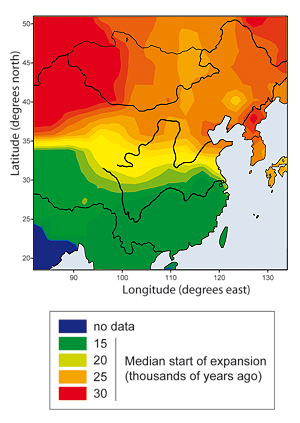Mammoths Maketh Man
 A rich diet of mammoth meat helped some tribes of early man to develop more quickly than their plant-eating contemporaries, scientists have discovered. Research published in Genetics by an international team led by Dr Chris Tyler-Smith from the Wellcome Trust Sanger Institute shows that northern and southern populations in East Asia followed dramatically different fates around 30,000 years ago. The growth of the northern populations might have occurred simply because they could hunt and eat mammoths: an abundant source of nutrition.
A rich diet of mammoth meat helped some tribes of early man to develop more quickly than their plant-eating contemporaries, scientists have discovered. Research published in Genetics by an international team led by Dr Chris Tyler-Smith from the Wellcome Trust Sanger Institute shows that northern and southern populations in East Asia followed dramatically different fates around 30,000 years ago. The growth of the northern populations might have occurred simply because they could hunt and eat mammoths: an abundant source of nutrition.
This genealogy on a grand scale used Y chromosome sequences to look at 27 populations in China, Mongolia, Koreas and Japan. The populations in the northern areas expanded between 34,000 and 22,000 years ago, before the last Ice Age (around 20,000 years ago). The southern populations expanded only after 18,000-12,000 years ago.
“Although previous studies have looked at population changes averaged over large areas, this is the first analysis that has the resolution to look at local changes. The differences are dramatic and speak of very dissimilar conditions in the regions north and south of the Yangtze (Changjiang) River.”
Dr Chris Tyler-Smith Principal Investigator of the project at the Wellcome Trust Sanger Institute
“When we first saw them, we thought our calculations must be wrong. But the differences would not go away. The genetic record clearly told us there were two different stories for the peoples of this region.”
Yali Xue Wellcome Trust Sanger Institute
To study human populations, researchers analyse the frequencies of DNA sequence variations. The Y chromosome is especially useful because it is inherited only through the male line and therefore analysis is simpler. A long-established or a large population will tend to have more variation: a young population, or one derived from a relatively small set of ‘founders’, will have less.
Two types of Y-chromosome marker are used to study male lineages in human populations. One, binary markers, looks at base differences in Y-chromosome sequence, but can be biased because they are based on preselected DNA markers from known populations. The second, short tandem repeats (STRs) or microsatellites, is essentially free of this bias because STRs are variable in all populations.
In this study, Tyler-Smith and colleagues found greatest levels of variation of Y-chromosome sequence in the populations from the north of the region, around modern Mongolia and northern China. This contrast between north and south was consistent for all groups studied and suggested all northern groups started to expand before the last Ice Age whereas all southern groups started to expand after it.
While the extreme north of Asia was inhospitable to humans, Siberia supported an abundance of large mammals – most notable, to modern eyes, the mammoth. By contrast, the southern regions did not support significant numbers of large mammals and the population expanded only after the Ice Age – perhaps as the populations used plant products, such as tubers, on a significant scale.
“We asked ourselves: ‘What differentiated these two groups? What was different about the environment in the north?’ The most appealing explanation is the vast abundance of the ‘Mammoth Steppe’ – a time and a region when large numbers of grazing animals and their predators roamed the grassy plains.
“At that time, the southern regions of East Asia were probably densely forested and impenetrable to humans.
“The only robust explanation for the early success of the northern populations is that they enjoyed a better and richer diet: they thrived on mammoths and other large animals.”
Dr Chris Tyler-Smith Sanger Institute
The marked differences in fortunes of populations from the two regions are recognized today by the fine-scale analysis: indeed, if the populations were studied as one group, the two-phase expansion would be masked. Only by careful and rigorous analysis are the differences detected.
More information
Participating Centres
- The Wellcome Trust Sanger Institute, Wellcome Trust Genome Campus, Hinxton, Cambs., UK
- Department of Medical Biology, Harbin Medical University, Harbin, China
- Department of Biochemistry, University of Oxford, Oxford, UK
- nstitute of Genetics, Chinese Academy of Sciences, Beijing, China
Supporting Agencies
This work was supported by a Joint Project from the National Natural Science Foundation in China and The Royal Society in the UK, Key Teacher support from the Education Office of Heilongjiang Province, and by The Wellcome Trust.
Publications:
Selected websites
The Wellcome Trust Sanger Institute
The Wellcome Trust Sanger Institute, which receives the majority of its funding from the Wellcome Trust, was founded in 1992. The Institute is responsible for the completion of the sequence of approximately one-third of the human genome as well as genomes of model organisms and more than 90 pathogen genomes. In October 2006, new funding was awarded by the Wellcome Trust to exploit the wealth of genome data now available to answer important questions about health and disease.
The Wellcome Trust and Its Founder
The Wellcome Trust is the most diverse biomedical research charity in the world, spending about £450 million every year both in the UK and internationally to support and promote research that will improve the health of humans and animals. The Trust was established under the will of Sir Henry Wellcome, and is funded from a private endowment, which is managed with long-term stability and growth in mind.


